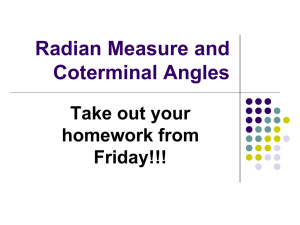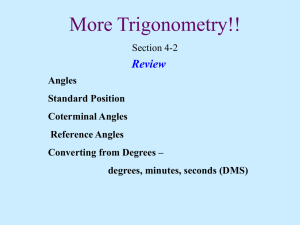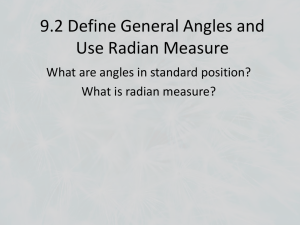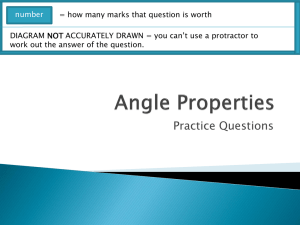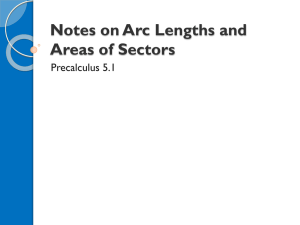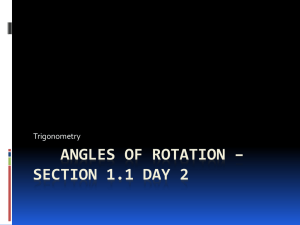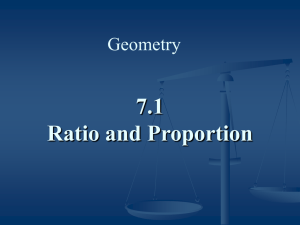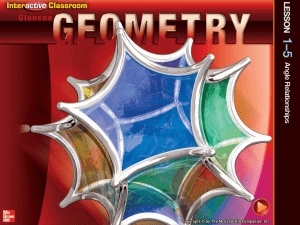Radian and Degree Measure
advertisement
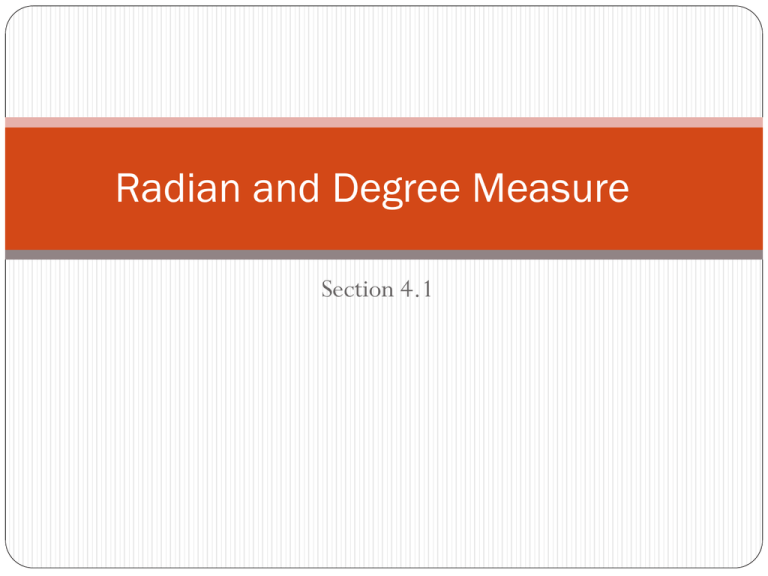
Radian and Degree Measure Section 4.1 Radian and Degree Measure We will begin our study of precalculus by focusing on the topic of trigonometry Literal meaning of trigonometry The measurement of triangles Thus, we will be spending a lot of time working with and studying different triangles Radian and Degree Measure To begin our study on trigonometry, we first start with angles and their measures An angle is determined by rotating a ray (half-line) about its endpoint. Vertex Radian and Degree Measure Standard Position An angle in standard position has 2 characteristics: 1) Initial side lies on the x-axis 2) Vertex is at the origin y x Radian and Degree Measure Standard Position An angle in standard position has 2 characteristics: 1) Initial side lies on the x-axis 2) Vertex is at the origin y x Radian and Degree Measure Standard Position An angle in standard position has 2 characteristics: 1) Initial side lies on the x-axis 2) Vertex is at the origin y x Radian and Degree Measure Positive Angles Rotate clockwise In standard position, start by going up Negative Angles Rotate counterclockwise In standard position, start by going down Radian and Degree Measure Negative Angle Radian and Degree Measure Positive Angle Radian and Degree Measure Angles can be measured in one of two units: 1) Degrees 2) Radians One full revolution of a central angle would be equal to: 1) 360º 2) 2π radians (or 6.28 radians) Radian and Degree Measure In radians, there are common angles that will need to be 2 memorized = 180º = 90º 2 3 = 270º 2 3 2 Radian and Degree Measure In addition to our quadrant angles, there are 3 more angles that we will be using throughout the year. = 30º 6 = 45º 4 = 60º 3 3 4 6 Radian and Degree Measure Coterminal Angles Two angles that have the same: Vertex Initial Side Terminal Side All angles have an infinite number of coterminal angles Radian and Degree Measure Finding Coterminal angles To find a positive coterminal angle Add 2π (or 360º) to the given angle To find a negative coterminal angle Subtract 2π (or 360º) from the given angle Radian and Degree Measure Graph the following angle and determine two coterminal angles, one positive and one negative. 5 6 5 17 2 6 6 6 6 5 7 2 6 6 3 26 0 39 26 12 6 Radian and Degree Measure Graph the following angles and find two coterminal angles, one positive and one negative. a) 4 7 b) 6 4 c) 3 d) 2 Radian and Degree Measure a) 4 2 4 4 4 9 pos : 2 4 4 7 neg : 2 4 4 0 6 4 Radian and Degree Measure 7 b) 6 3 6 6 6 7 19 pos : 2 6 6 7 5 neg : 2 6 6 0 9 6 Radian and Degree Measure 4 c) 3 4 2 pos : 2 3 3 4 11 neg : 2 3 3 Radian and Degree Measure d) 2 pos : neg : 2 2 2 2 3 2 5 2 Radian and Degree Measure Section 4.1 Radian and Degree Measure Graph the following angles and find two coterminal angles, one positive and one negative. 11 1) 4 2 2) 3 Radian and Degree Measure 11 1) 4 2 2) 3 19 3 P: , 4 4 5 N : 4 4 P: 3 8 N : 3 Radian and Degree Measure Yesterday we covered: Angles in degrees and radians Coterminal angles Today we are going to cover: Complementary and supplementary angles Converting between degrees and radians Converting minutes & seconds to degrees Radian and Degree Measure Complementary Angles Two positive angles whose sum is (or 90º) 2 Supplementary Angles Two positive angles whose sum is π of (180º) Radian and Degree Measure Find the complement and supplement to the following angle. 2 5 2 complement: 2 5 supplement: 10 3 2 5 5 Radian and Degree Measure Find the complement and supplement of the following angles: 7 b) 8 a) 3 comp : 6 2 sup : 3 comp : sup : 8 3 c) 7 comp : 14 4 sup : 7 Radian and Degree Measure Conversions between degrees and radians 1. To convert degrees to radians, multiply degrees by: rad 180 o 2. To convert radians to degrees, multiply radians by: o 180 rad Radian and Degree Measure Degrees to Radians 135 ) 135 ( o o 180 180 o rad 3 4 Radians to Degrees 7 180 7 (180 ) o ( ) 210 6 rad 6 o Radian and Degree Measure Convert the following from degrees to radians. 270 3 ) ( ) a)270 ( o o 180 180 2 o rad 540 ) ( ) 3 b)540 ( o o 180 180 o rad 225 5 ) ( ) c) 225 ( o o 180 180 4 o rad Radian and Degree Measure Convert the following from radians to degrees. 180o 180 a) ( ) 90o 2 rad 2 o 11(180 ) 180 11 o ( ) 330 b) 6 6 rad o 180 360 o ) c)2 rad ( 114.59 rad Radian and Degree Measure Section 4.1 Radian and Degree Measure Find the complement, supplement, and two coterminal angles of the following angle. 4 9 5 22 14 , , , 18 9 9 9 Convert the angle above to degrees. o 80 Radian and Degree Measure So far in this section, we have: Graphed angles in both radians & degrees b) Found positive and negative coterminal angles c) Found complementary and supplementary angles d) Converted between radians and degrees a) Today we are going to apply this to different word problems (arc length, linear speed, angular speed) Radian and Degree Measure Arc Length The distance along the circumference of a circle with a central angle of θ Given by the formula: s = r θ Where: s = the arc length r = the radius of the circle θ = the central angle in radians Radian and Degree Measure A circle has a radius of 4 inches. Find the length of the arc intercepted by a central angle of 240º. 1) Convert the angle to radians. 2) rad 4 ) 240 ( o 180 3 o Apply the formula. 4 S = (4) =16.7 inches 3 Radian and Degree Measure On a circle with a radius of 9 inches, find the length of the arc intercepted by a central angle of 140º. rad 7 ) 140 ( o 180 9 o 7 S = (9) = 22 inches 9 Radian and Degree Measure Linear & Angular Speed Linear speed measures how fast a particle is moving along the circular arc of a circle with radius r Given by the formula: arc length s time t Radian and Degree Measure Linear & Angular Speed Angular speed measures how fast the angle changes Given by the formula: central angle t time Radian and Degree Measure The second hand of a clock is 11 inches long. Find the linear speed of the tip of this second hand as it passes around the clock face. In one revolution, how far does the tip travel? r = 11 inches s = 2π r = 22π inches What is the time required to travel this distance? t = 60 seconds Radian and Degree Measure The second hand of a clock is 11 inches long. Find the linear speed of the tip of this second hand as it passes around the clock face. s = 22π inches Linear Speed = t = 60 seconds s 22 inches 60 seconds t 1.15 in/sec Radian and Degree Measure A car is moving at a rate of 65 mph, and the diameters of its wheels is 2.5 feet. a) Find the number of revolutions per minute the wheels are rotating. b) Find the angular speed of the wheels in radians per minute. Radian and Degree Measure A car is moving at a rate of 65 mph, and the diameters of its wheels is 2.5 feet. a) Find the number of revolutions per minute the wheels are rotating. Find the arc length for one revolution: S = r θ = (1.25) (2π) = 2.5 π feet per revolution How many feet per hour is the car traveling? (65 mph ) (5,280 feet) = 343,200 feet/hour = 5,720 feet/min = 728.3 revolutions Radian and Degree Measure A car is moving at a rate of 65 mph, and the diameters of its wheels is 2.5 feet. b) Find the angular speed of the wheels in radians per minute. (728.3 revolutions) (2π) = 4,576 radians Angular Speed 4,576 rad. t 1 min. 4,576 rad/min Radian and Degree Measure A car is moving at a rate of 35 mph, and the radius of its wheels is 2 feet. a) Find the number of revolutions per minute the wheels are rotating. 245.1 revolutions per minute b) Find the angular speed of the wheels in radians per minute. 1,540 rad/min Radian and Degree Measure
